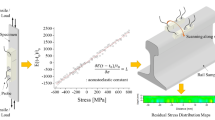Abstract
Continuously welded rails are a part of the track structure since the 1950s. Total stresses in continuously welded rails include residual stresses generated during the manufacturing process as well as the service life of rails. The control of rail stresses is very important for traffic safety. Measurement methods for residual stress in rails are presented in this paper. Since destructive measurement methods are unsuitable for use in the railway track, the modern non-destructive methods were particularly presented and discussed. The advantages and disadvantages of X-ray diffraction, ultrasonic, magnetic and electromagnetic methods are particularly explained and considered.
Access this chapter
Tax calculation will be finalised at checkout
Purchases are for personal use only
Similar content being viewed by others
References
Nejad, R.M., Shariati, M., Farhangdoost, K.: Three-dimensional finite element simulation of residual stresses in UIC60 rails during the quenching process. Therm. Sci. 21(3), 1301–1307 (2017)
Popović, Z., Lazarević, L., Brajović, L., Gladović, P.: Managing rail service life. Metalurgija 53(4), 721–724 (2014)
European Rail Research Institute: Verbesserung der Kenntnis der Kräfte im lückenlose Gleis (einschließlich Weichen): Schlußbericht (ERRI D 202/RP 12), Utrecht (1999)
CEN: EN 13674-1 - Railway applications – Track – Rail - Vignole railway rails 46 kg/m and above, Brussel (2017)
Mirković, N., Popović, Z., Pustovgar, A., Lazarević, L., Zhuravlev, A.: Management of stresses in the rails on railway bridges. FME Trans. 46(4), 636–643 (2018)
DIN: Fachtbericht 101 - Einwirkungen auf Bruecken, Deutschland (2003)
Popović, Z., Radović, V.: Analysis of cracking on running surface of rails. Gradjevinar 65(3), 251–259 (2013)
Popović, Z., Lazarevic, L., Vatin, N.: Railway gauge expansion in small radius curvature. Proc. Eng. 117(1), 841–848 (2015)
Popović, Z., Lazarević, L., et al.: The importance of rail inspections in the urban area - aspect of head checking rail defects. Proc. Eng. 117(1), 596–608 (2015)
Popović, Z., Lazarević, L., et al.: The modal shift to sustainable railway transport in Serbia. In: MATEC Web of Conferences, vol. 106, paper 05001 (2017)
UIC: UIC - Merkblatt Nr. 712 – Schienenfehler, Paris (2002)
Fitzpatrick, M., Fry, A., et al.: NPL Measurement Good Practice Guide No. 52. Determination of Residual Stresses by X-ray Diffraction. NPL Teddington, UK (2005)
ERRI Committee D 173/RP42: Rail rolling contact fatigue - Residual stress measurements on naturally hard and two head-hardened rails by neutron diffraction, Utrecht (1993)
Li, Z., He, J., Teng, J., Wang, Y.: Internal stress monitoring of in-service structural steel members with ultrasonic method. Materials 9, 223–240 (2016)
Szelazek, J.: Monitoring of thermal stresses in continuously welded rails with ultrasonic technique. Electromagn. Nondestruct. Test. 3(6) (1998)
Vangi, D., Virga, A.: A practical application of ultrasonic thermal stress monitoring in continuous welded rail. Exp. Mech. 47, 617–623 (2007)
Buttle, J., Moorthy, V., Shaw, B.: NPL Measurement Good Practice Guide No. 88 - Determination of Residual Stresses by Magnetic Methods. NPL, Teddington (2006)
Lugg, M., Topp, D.: In: Proceedings of ECNDT 2006, Berlin, Germany, pp. 1–14 (2006)
Utrata, D., Strom, A., et al.: In: Thompson, D.O., Chimenti, D.E. (eds.) Review of Progress in Quantitative Nondestructive Evaluation, pp. 1683–1691. Springer, Boston (1995)
Acknowledgements
This work was supported by the Ministry of Education, Science and Technological Development of the Republic of Serbia through the research project No. 36012: “Research of technical-technological, staff and organization capacity of Serbian Railway, from the viewpoint of current and future European Union requirements”.
Author information
Authors and Affiliations
Corresponding author
Editor information
Editors and Affiliations
Rights and permissions
Copyright information
© 2020 Springer Nature Switzerland AG
About this paper
Cite this paper
Mirković, N., Brajović, L., Malović, M., Vnenk, P. (2020). Measurement Methods for Residual Stresses in CWR. In: Murgul, V., Pasetti, M. (eds) International Scientific Conference Energy Management of Municipal Facilities and Sustainable Energy Technologies EMMFT 2018. EMMFT-2018 2018. Advances in Intelligent Systems and Computing, vol 982. Springer, Cham. https://doi.org/10.1007/978-3-030-19756-8_32
Download citation
DOI: https://doi.org/10.1007/978-3-030-19756-8_32
Published:
Publisher Name: Springer, Cham
Print ISBN: 978-3-030-19755-1
Online ISBN: 978-3-030-19756-8
eBook Packages: Intelligent Technologies and RoboticsIntelligent Technologies and Robotics (R0)




